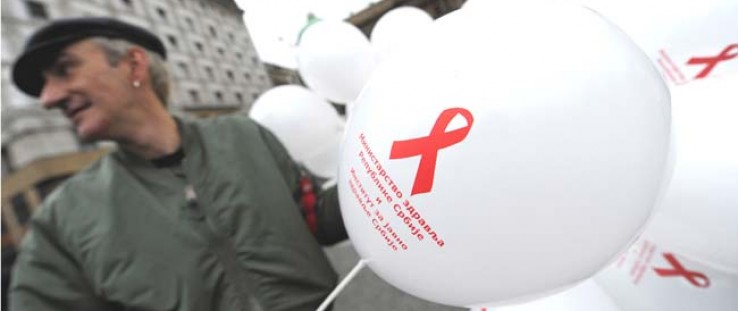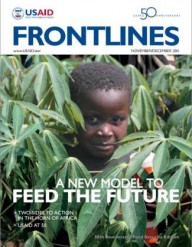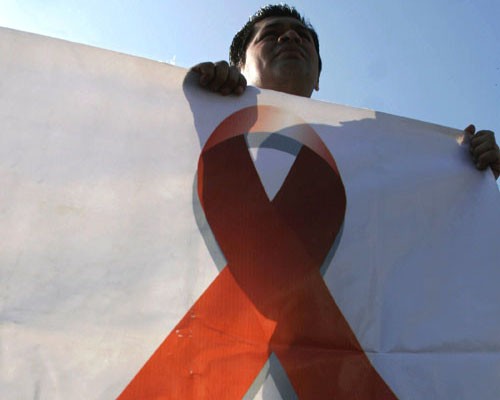 A Serbian activist holds balloons Dec. 1, 2010, during a World AIDS Day rally in the center of Belgrade. At the time, a U.N. expert said that complacency among young people was causing a new surge of the AIDS epidemic in the United States and European nat
CREDIT: ANDREJ ISAKOVIC, AFP
A Serbian activist holds balloons Dec. 1, 2010, during a World AIDS Day rally in the center of Belgrade. At the time, a U.N. expert said that complacency among young people was causing a new surge of the AIDS epidemic in the United States and European nat
CREDIT: ANDREJ ISAKOVIC, AFP
 A Serbian activist holds balloons Dec. 1, 2010, during a World AIDS Day rally in the center of Belgrade. At the time, a U.N. expert said that complacency among young people was causing a new surge of the AIDS epidemic in the United States and European nat
CREDIT: ANDREJ ISAKOVIC, AFP
A Serbian activist holds balloons Dec. 1, 2010, during a World AIDS Day rally in the center of Belgrade. At the time, a U.N. expert said that complacency among young people was causing a new surge of the AIDS epidemic in the United States and European nat
CREDIT: ANDREJ ISAKOVIC, AFP
USAID has been on the forefront of the HIV epidemic for over 25 years, working to save lives while consistently pushing for greater sustainability, strengthened capacity, and innovation—all major hallmarks of the Agency since its inception 50 years ago.
Since the early years of the epidemic, USAID has understood the critical need for sustainable and preventive approaches to addressing HIV and AIDS. Twenty-five years ago, there were no effective drug therapies to treat people living with HIV. According to many experts, programs that addressed surveillance of the epidemic, and promoted behavior change and condom use, were the most viable way to effectively respond to a global public health crisis that had enormous humanitarian, socio-economic, demographic, and cultural implications.
In 1985, only 20,000 cases of AIDS had been reported to the World Health Organization. But with rates of infection increasing rapidly, it was clear that the numbers would multiply quickly. “The AIDS epidemic swept across the developing world faster than any of us could have imagined,” said David Stanton, chief, Technical Leadership and Research Division in USAID’s Office of HIV/AIDS. “Most of us working in the field at the time could not have imagined the impact it has had on millions of people worldwide.”
The Early Years
Rewind to 1986.
USAID officially begins its HIV/AIDS efforts in the developing world and establishes the first AIDS program two years after the virus has been isolated and identified. With just $2 million, the Agency embarks on a long mission to fight the disease.
Two years later, USAID’s Demographic and Health Survey project begins collecting data on HIV. Seven years later—by 1993—USAID becomes one of the founding members of the International HIV/AIDS Alliance—a global partnership of nationally based organizations working to support community action on AIDS in developing countries.
Through the 1990s, new HIV infections continue to increase at an alarming rate. This comes to a head late in the decade, when the number of estimated new infections per year reaches a high point at 5.8 million.
In response to the increasing epidemic, in the early 1990s, USAID stands up a specialized HIV/AIDS division within its health office, a centralized support center for its field programs. “In order to effectively meet the expanding needs of the global epidemic, USAID launched a series of centrally managed programs in the 1990s which grew by leaps and bounds in both resource commitments and the scope of activities,” said Shanti Conly, HIV prevention team lead in USAID’s Office of HIV/AIDS.
Two complementary projects—AIDSCOM (AIDS Public Health Communications) and AIDS TECH (AIDS Technical Support)—both launch in 1987. AIDSCOM supports mass media campaigns, condom social marketing, and peer education for young people. AIDSTECH focuses on HIV prevention among high-risk populations, especially sex workers, and on prevention of blood-borne transmission through improved blood screening and transfusion practices.
In 1992, USAID launches the AIDSCAP (AIDS Control and Prevention) project, which over its lifetime collaborates with 300 local partners in 42 countries to implement HIV prevention programs. It is the largest program of its kind at the time.
Ramping up for Maximum IMPACT
In 1998, USAID launches its next generation IMPACT (Implementing AIDS Prevention and Care) project, which becomes a cornerstone of USAID’s HIV/AIDS response over the next decade, a time when needs were rapidly growing.
IMPACT addresses everything from behavior changes to blood safety; from reducing transmission from drug use to voluntary counseling and testing; from home-based and palliative care to work with orphans and vulnerable children; and from prevention of mother-to-child transmission to the first antiretroviral treatments in the developing world. It develops improved methods to track the epidemic.
“IMPACT broadened the scope of USAID’s response to encompass nearly every aspect of the HIV/AIDS continuum of care,” said Stanton.
He adds: “In the ’90s, USAID HIV programs focused on public education and prevention with the goal of changing risky behaviors and shaping attitudes about the epidemic. We knew it was important to build programs that cultivated capacity in-country.”
The program also expands USAID’s HIV/AIDS portfolio into new geographic territory. Between 1997 and 2008, the $441 million project grows USAID’s role in the AIDS response to 75 countries in Africa, Asia, the Caribbean and the Baltics, working to build the capacity of more than 1,500 local organizations to address HIV prevention and care needs.
Understanding the importance of behavior change communication and social marketing early on, USAID launches AIDSMark around the same time as it ramped up with IMPACT. It is a global initiative to reduce HIV transmission by expanding social marketing of HIV prevention products and services, using private sector strategies to promote behavior change, condom use, and HIV testing.
“AIDS was an uncomfortable issue for many people because it involves sex. It was often difficult to garner support around the issue,” said C. Kirk Lazell, the senior project development officer in USAID’s Office of HIV/AIDS. “That’s why programs like IMPACT and AIDSMark were so innovative at the time. Stigma surrounded the disease in the 1990s and a diagnosis was often hidden. Promoting open discussion about HIV/AIDS was of the upmost importance.”
Children on the Brink
In 1997, USAID publishes its first in a series of reports on children orphaned by AIDS, “Children on the Brink.” As a result, the international donor, scientific, and advocacy communities begin rallying around the needs of HIV/AIDS-affected children, jump-starting a series of landmark activities that begin in the late 1990s and continue into the next millennium. In 1998, the U.S. Government launches a series of initiatives to address the HIV/AIDS pandemic worldwide, including providing USAID with an additional $10 million to provide support to orphans and other children made vulnerable as a result of HIV and AIDS.
While prevention and care programming is in place, treatment on a large scale is still lacking in the late 1990s. At that time, the cost of antiretrovirals—lifesaving medicine—was up to $15,000 per patient each year and it was impossible to build an affordable treatment program. USAID continues to reach the most vulnerable populations, including children and mothers. But, working with limited resource countries, this is sometimes a challenge.
“Hospitals, health centers, and rural clinics were overwhelmed with taking care of the sick and dying,” said Lazell. “In some places, 75 percent of hospital admissions were attributable to AIDS; therefore, there was a limited amount of resources and space for other urgent health-care issues such as malaria, tuberculosis, providing safe delivery for mothers, and immunizations for children.”
By 1997, Congress is directing nearly $123 million per year to address HIV/AIDS worldwide.
Around this time, USAID launches its initial prevention of mother-to-child transmission programs. Starting in Kenya, USAID provides training to health-care workers, renovates clinics, and recommends policy.
At the turn of the century, the Agency develops a strong foothold and launches its regional HIV/AIDS program for Southern Africa. At this time, Africa is home to 70 percent of the adults and 80 percent of the children living with HIV. The disease continues to rise on the continent as an estimated 3.8 million people in Africa became newly infected with HIV in 2000. At the start of the new millennium, the Agency also holds the first international meeting on male circumcision, uniting over 150 experts from around the world to discuss the feasibility of using male circumcision to prevent HIV from spreading.
“In the late 1990s and early 2000s, we started hearing rumblings about the positive effects of male circumcision. The randomized trials didn’t come out until at least six years later, but early scrutinizing of studies showed that male circumcision could reduce the risk of HIV infection by at least 50 percent,” said Daniel Halperin, former senior technical adviser at USAID. “At USAID, we knew we had to explore the acceptability, feasibility, safety, and cost-effectiveness of this intervention.”
Pilot programs are soon launched in Zambia, Haiti, South Africa, and Swaziland.
“The Zambia program really set out to study whether male circumcision was a feasible prevention tool,” said Halperin. “Were men interested in getting this procedure performed in a clinical setting? Could we deliver it safely? Was it efficient? The answers to all these questions seemed to be ’yes.’ We felt then that male circumcision could eventually become a big part of HIV prevention programming.”
The Emergency Response and Beyond
By 2001, AIDS cases had ballooned enough to be recognized as having huge potential implications for all health programming and for development advances in general. USAID increases momentum around the epidemic by restructuring internally at headquarters to transform the HIV/AIDS division to a fully functioning office.
“In the early 2000s, one in five Zambians was HIV-positive. At that point, the epidemic had been underway for 15 years and illness and death were at an all-time peak,” said Robert Clay, deputy assistant administrator for the Bureau for Global Health and the former director of USAID’s Office of HIV/AIDS.
A Foreign Service Officer in Zambia at the time, Clay saw the effects of the AIDS epidemic first hand. “Our home was on the road to the city cemetery, and long funeral processions were daily occurrences,” he said.
That same year, the Agency announces its partnership with the International AIDS Vaccine Initiative, which is committed to developing AIDS vaccines that are safe, effective, and accessible to everyone.
In 2002, with 40 million people living with HIV/AIDS worldwide, then-President George W. Bush announces a $500 million initiative to prevent the transmission of HIV from mothers to infants and to improve health-care delivery in 14 countries in Africa and the Caribbean.
On January 28, 2003, the President’s Emergency Plan for AIDS Relief (PEPFAR) becomes the largest commitment by any nation for an international health initiative dedicated to a single disease. The first phase of PEPFAR is a five-year, $18 billion, multifaceted approach to combating one of the world’s deadliest diseases. In late 2003, USAID helps launch PEPFAR by supporting centrally funded grants to NGOs to scale up youth prevention, orphans and vulnerable children, and injection safety activities. (Today, USAID manages approximately 60 percent of the U.S. Government’s HIV/AIDS programs, amounting to $3.5 billion in funding in fiscal year 2010.)
USAID also begins to make gains in countries with concentrated epidemics. Prevention programs scale up to address populations at highest risk in Asia, Latin America and the Caribbean, and Eastern Europe, especially commercial sex workers, injecting drug users, and men having sex with men. The focus proved a smart one, pushing HIV rates in the general population to lower levels.
“In places like Southern India and Cambodia, USAID’s laser-like focus on increased condom use for sex workers and their clients, and the fact that we were in this for the long haul, helped reverse the tide of the epidemic,” said Conly. “In Tamil Nadu, where USAID provided assistance for almost two decades, HIV prevalence among pregnant women has fallen by about 80 percent, and USAID is now phasing out support.”
In Cambodia, too, a focus on high-risk groups helped reduce HIV prevalence among pregnant women receiving prenatal care in clinical facilities by 50 percent.
In 2005, the Agency launches the Supply Chain Management System as a way to provide an uninterrupted supply of quality and affordable antiretroviral drugs and other essential medicines and supplies. The following year, USAID takes on management of the PEPFAR New Partners’ Initiative, an effort to expand the traditional base of partner organizations working in HIV.
In the second phase of PEPFAR—reauthorized in 2008 for $48 billion to address HIV/AIDS, tuberculosis, and malaria through 2013—the emphasis shifts to building sustainable, country-owned programs that integrate HIV/AIDS services into broader health systems for greater efficiency. Through the Partnership Frameworks, five-year joint agreements between the U.S. Government and partner governments, a sense of shared responsibility is instilled in the work between PEPFAR, the countries, and other implementing partners.
Ambassador Eric Goosby, U.S. global AIDS coordinator, has said in the past: “We feel strongly that it is a shared responsibility among all donors and recipient nations to continue to make smart investments that ultimately improve and save more lives.”
“This shift in thinking and policy takes USAID back to the ’development lens’ that is its comparative advantage, and which has historically and to this day focused on sustainable and scalable systems, an approach that is unique within the U.S. Government,” said Roxana Rogers, director of USAID’s Office of HIV/AIDS.
In 2010, a year after President Barack Obama announces his Global Health Initiative, which helps countries improve health outcomes through strengthened health systems, the CAPRISA 004 trial—a PEPFAR-funded USAID research initiative—provides the first proof of concept that a microbicide—in this case, in the form of a vaginal anti-viral gel—can prevent HIV transmission. “USAID’s work in microbicide research and development spans over two decades. There have been challenges and setbacks, but CAPRISA was the first time we were able to point to a microbicide trial with a positive outcome,” said Stanton. “The success of CAPRISA is so important because a microbicide is—to date—the only prevention method a woman can initiate and use without the consent of her partner.”
With women now accounting for more than half of all global AIDS cases, development experts believe a woman-controlled prevention method is imperative to fighting the disease. As a follow-up to CAPRISA, USAID, through PEPFAR, in conjunction with the South African Government and the Gates Foundation, is funding a new trial, FACTS 001, to confirm the effectiveness of its CAPRISA findings.
Looking Ahead
A quarter century after the first cases were detected, HIV/AIDS remains one of the most compelling global health challenges. Each year an estimated 1.8 million people die of AIDS and 2.4 million are newly infected. Today, 34 million people are living with HIV.
Still, over nearly three decades of dedication, USAID, through strong partnerships, has built a strong network of HIV prevention, care, and treatment programs. The Agency’s future work lies in building greater sustainability within countries.
“As always, USAID will continue to find the most effective and efficient way to deliver HIV/AIDS services to those most in need,” said Rogers. “Through new technologies and innovative approaches, USAID continues to provide lifesaving services to those in need, now in a more efficient way.”











Comment
Make a general inquiry or suggest an improvement.